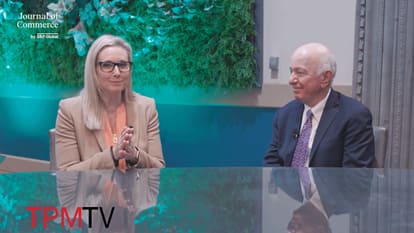- Program
- Speakers
- Who's Attending
- TPM Community
- Partners
- Media

TPM TV
Episodes of exclusive TPM content featuring interviews of key stakeholders and attendees.
WATCH NOW - About

About TPM
The must-attend conference for the trans-Pacific and global container shipping and logistics community
LEARN ABOUT TPM - FAQ's
- Get Updates
- Register
Finding Reliability in an Unreliable World
The decisive re-election of Donald Trump on Nov. 5 instantly introduces yet another category of container supply chain upheaval – the distinct possibility of a trade war can be added to a list that already includes carrier bankruptcy, labor unrest, climate change, pathogen and regional conflict.
Just like in late 2018 when US ports saw a debilitating surge of late-year front loading ahead of threatened Trump tariffs on China – 4Q Port of Los Angeles volumes were up xxx that year – another surge is almost certainly already in the works. Long term, sourcing will shift further; short term, front loading will be the priority.
For weary shippers that only means one thing, though the scale is still unknown: the potential for tighter capacity and higher rates, at exactly the time of year when the market level is being set ahead of contract negotiations. For shippers, hope that 2025 would settle down into a more normal year where overcapacity due to a slew of deliveries would materialize and pressure rates downward, has already begun to recede.
Thus, nearly five years after the onset of Covid, shippers of ocean containerized freight have become all too used to the worst of all worlds—stubbornly poor reliability combined with periods of historically high rates—and little they can do about it.
Worse is a growing perception that ocean carriers, some of whom prided themselves in years past on schedule integrity, now see disruption irrespective of the source as a factor acting decisively in their favor.
After all, when ships ran on schedule and cargo moved fluidly through ports, carriers rarely made money. It was when cargo stopped moving, ports backed up and ships by the dozens waited off shore, the capacity effectively removed from the market, that carriers experienced the greatest profitability their industry had ever seen.
The hope was that 2025 would be a year of normalization, but those hopes could be dashed the same they were in 2024, also a year of potential overcapacity that never materialized.
The container fleet was estimated to grow 23% from 2023-2026, initially giving shippers hope that overcapacity would rear its head in 2024, which never happened because of the Red Sea diversions and unexpectedly strong demand from front-loading and recession-free industrialized economies. In 2025 many believe the crush of overcapacity can’t be avoided, even if carriers claim they can avoid it due to blank sailings, a renewal of slow steaming, scrapping and weather delays. Carriers are facing 2025 capacity growth of 9% against volume growth of approximately 3%, according to S&P Global Market Intelligence.
Amid all of that, there is serious doubt that schedule integrity will return to ocean carrier operations, the one possible exception being the Gemini Cooperation network to be rolled out by Maersk and Hapag-Lloyd in early 2025.
The Gemini hub and spoke network to be implemented in the first quarter of 2025 aims to avoid delays at a single port delaying all subsequent arrivals on a multi-port string. It is intended to present to the shipping public a stark alternative to the prevailing reality of blanked sailings and skipped port calls.
Further complicating the environment for shippers, as the market witnessed in the spring of 2024, market conditions can and will change on a dime. Emboldened ocean carriers will not miss opportunities to profit from market tightness.
As the market saw in the spring of 2024 it pivoted with little warning, from one of feared overcapacity where carriers were forecasting a down year despite the Red Sea diversions, and BCOs signed annual contracts at normalized rates as low as $1500 per FEU, to a suddenly red hot market where transpacific spot rates were drive up to nearly $8000 in early July and Asia-Europe rates exceeded $8,000 per FEU around the same time, according to S&P Global Commodity Insights.
And yet despite the almost impossible task of predicting the market in the current environment, it’s still possible to identify big-picture themes that will still very much be playing out when the 25th annual TPM convenes on March 2-5, 2025.
- What will be the impact on containerized trade from the soon to be second Trump presidency? He has already threatened tariffs of 60% on goods imported from China and 20% on goods from elsewhere in the world. There will be both short term front-loading and longer term sourcing implications.
- Is service consistency worth even wishing for at this point? A high priority of many shippers is reducing cost, as shown by a recent Alcott Global survey, partly driven by a need to reduce inventory costs that have been propped up by higher interest rates. Any dialing back of “just-in-case” buffer, however, requires service consistency, and that is sorely lacking: As of early July, carrier on-time performance was a sobering 52%, according to Sea-Intelligence. With the Red Sea crisis continuing with no end in sight, and with carriers seeing disruption as an advantage, it is unclear what the future of service consistency is unless Maersk and Hapag-Lloyd can decisively deliver on their promise of 90%+ reliability.
- Tariffs’ potential to wreak havoc on trade flows. Newly imposed tariffs and campaign rhetoric only reinforce further how globalization is a bygone era. Biden administration tariffs announced in May on Chinese solar cells, semiconductors, lithium-ion batteries, and electric vehicles could be expanded and/or intensified by a second Trump administration, whose tariffs on $350 billion in Chinese imports Biden left untouched. Candidate Trump has threatened 60% tariffs on all China imports. By TPM25 it will be much more clear what the general direction of US trade policy will be.
- Is overcapacity inevitable? More than 200 container ships totaling 1.5 million TEU in capacity are still scheduled to be delivered in 2024 as of early May, according to S&P Global. Given that, many industry analysts believe overcapacity will return with a vengeance as soon as the spring 2024 volume runs its course. But some dispute this, believing the Red Sea diversions could endure for a while, many strings still require additional ships, and vessel speeds around the Cape of Good Hope are still faster than carriers would like. In addition, new International Maritime Organization rules to curb greenhouse gases will begin to bite in 2025, leaving increasing numbers of older ships uneconomic.
- Did ocean carrier DNA change as a result of the pandemic? The market determines shippers’ and carriers’ leverage, and as of early fall 2024 the market remained tight and carriers held the advantage. But irrespective of the ebbs and flows of the market, is there evidence of a new mindset embedded in carriers’ behavior in 2024, where NVOs are being squeezed on named accounts and additional surcharges are being applied liberally? Many believe carriers are behaving in an atypically aggressive manner and that may be here to stay. Tough lessons learned during the pandemic are being applied. Carriers are not passing up opportunities as they may have in the past, and shippers and forwarders are feeling the impact.
- Supply chain disruption used to be the exception. Now it’s routine. What does it mean for shippers that supply chain shocks have occurred one after another since 2020, becoming the norm? How does a shipper build “resilience” when the source, timing or magnitude, or even existence of the next shock is unknown? Companies are looking to cut supply chain costs and avoid investing in resilience to threats that are theoretical at best. Logisticians who never paid attention to geopolitics are now parsing the headlines for signs of the next blunt force impact to supply chains.
- Shipping politics in the US flipped in favor of the shipper, a shift that is unlikely to change under a Trump presidency. The impact is being increasingly felt. The new detention and demurrage rule that took effect on May 28 is a fundamental change in the relationship between ocean carriers, shippers, forwarders, and truckers. As was the July 22 final rule on unreasonable refusal to deal. Both emerged out of OSRA-22, passed over the objections of ocean carriers, and after years of shippers’ complaints to the Federal Maritime Commission regarding carriers’ detention and demurrage policies. Unreasonable refusal to deal has been on the books since the 1980s but became a hot spot of shipper complaints during and since Covid. But there are even broader impacts from an FMC emboldened to serve US shipper interests, in terms of how shippers’ complaints are handled and possibly impacting chassis.
- What will the AI dividend in container shipping be? With the power of generative AI enabling historic breakthroughs in medicine, manufacturing, and energy, surely international shipping and logistics will not be untouched. But prior iterations in technology have brought only evolutionary – not revolutionary – change to the physical movement of goods, much of it underwhelming. Is AI any different? Is there a real dividend in the offing for the system overall for shippers, carriers, forwarders, or ports individually?
-
Watch the video to learn why you should attend TPM25.
Register Today
Join the premier conference for the global container shipping and logistics community.
Become a Partner
Start your partnership journey today.
